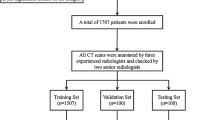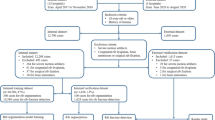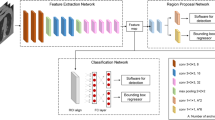Abstract
Objective
To compare rib fracture detection and classification by radiologists using CT images with and without a deep learning model.
Materials and methods
A total of 8529 chest CT images were collected from multiple hospitals for training the deep learning model. The test dataset included 300 chest CT images acquired using a single CT scanner. The rib fractures were marked in the bone window on each CT slice by experienced radiologists, and the ground truth included 861 rib fractures. We proposed a heterogeneous neural network for rib fracture detection and classification consisting of a cascaded feature pyramid network and a classification network. The deep learning-based model was evaluated based on the external testing data. The precision rate, recall rate, F1-score, and diagnostic time of two junior radiologists with and without the deep learning model were computed, and the Chi-square, one-way analysis of variance, and least significant difference tests were used to analyze the results.
Results
The use of the deep learning model increased detection recall and classification accuracy (0.922 and 0.863) compared with the radiologists alone (0.812 vs. 0.850). The radiologists achieved a higher precision rate, recall rate, and F1-score for fracture detection when using the deep learning model, at 0.943, 0.978, and 0.960, respectively. When using the deep learning model, the radiologist’s reading time was decreased from 158.3 ± 35.7 s to 42.3 ± 6.8 s.
Conclusion
Radiologists achieved the highest performance in diagnosing and classifying rib fractures on CT images when assisted by the deep learning model.






Similar content being viewed by others
References
Hamilton C, Barnett L, Trop A, Leininger B, Olson A, Brooks A, et al. Emergency department management of patients with rib fracture based on a clinical practice guideline. Trauma Surg Acute Care Open. 2017;2(1):e000133.
Shulzhenko NO, Zens TJ, Beems MV, Jung HS, O’Rourke AP, Liepert AE, et al. Number of rib fractures thresholds independently predict worse outcomes in older patients with blunt trauma. Surgery. 2017;161(4):1083–9.
Marasco S, Lee G, Summerhayes R, Fitzgerald M, Bailey M. Quality of life after major trauma with multiple rib fractures. Injury. 2015;46(1):61–5.
Sano A. Rib radiography versus chest computed tomography in the diagnosis of rib fractures. Thorac Cardiovasc Surg. 2018;66(8):693–6.
Expert Panel on Thoracic Imaging, Henry TS, Donnelly EF, Boiselle PM, Crabtree TD, Iannettoni MD, et al. ACR appropriateness Criteria® rib fractures. J Am Coll Radiol. 2019;16(5S):S227–34.
Lin FC, Li RY, Tung YW, Jeng KC, Tsai SC. Morbidity, mortality, associated injuries, and management of traumatic rib fractures. J Chin Med Assoc. 2016;79(6):329–34.
Cho SH, Sung YM, Kim MS. Missed rib fractures on evaluation of initial chest CT for trauma patients: pattern analysis and diagnostic value of coronal multiplanar reconstruction images with multidetector row CT. Br J Radiol. 2012;85(1018):e845–50.
Shelat VG, Eileen S, John L, Teo LT, Vijayan A, Chiu MT. Chronic pain and its impact on quality of life following a traumatic rib fracture. Eur J Trauma Emerg Surg. 2012;38(4):451–5.
Gyftopoulos S, Lin D, Knoll F, Doshi AM, Rodrigues TC, Recht MP. Artificial intelligence in musculoskeletal imaging: current status and future directions. AJR Am J Roentgenol. 2019;213(3):506–13.
Langerhuizen DWG, Janssen SJ, Mallee WH, van den Bekerom MPJ, Ring D, Kerkhoffs GMMJ, et al. What are the applications and limitations of artificial intelligence for fracture detection and classification in orthopaedic trauma imaging? A systematic review. Clin Orthop Relat Res. 2019;477(11):2482–91.
Kitamura G, Chung CY, Moore BE. Ankle fracture detection utilizing a convolutional neural network ensemble implemented with a small sample, de novo training, and multiview incorporation. J Digit Imaging. 2019;32(4):672–7.
Olczak J, Fahlberg N, Maki A, Razavian AS, Jilert A, Stark A, et al. Artificial intelligence for analyzing orthopedic trauma radiographs. Acta Orthop. 2017;88(6):581–6.
Pranata YD, Wang KC, Wang JC, Idram I, Lai JY, Liu JW, et al. Deep learning and SURF for automated classification and detection of calcaneus fractures in CT images. Comput Methods Prog Biomed. 2019;171:27–37.
Milletari F, Navab N, Ahmadi S-A. V-net: fully convolutional neural networks for volumetric medical image segmentation; 2016 Fourth International Conference on 3D Vision (3DV). 2016. p. 565–71.
He K, Zhang X, Ren S. Deep residual learning for image recognition//IEEE conference on computer vision & pattern recognition. IEEE Computer Society; 2016.
Zhou QQ, Wang J, Tang W, Hu ZC, Xia ZY, Li XS, et al. Automatic detection and classification of rib fractures on thoracic CT using convolutional neural network: accuracy and feasibility. Korean J Radiol. 2020;21(7):869–79.
Weikert T, Noordtzij LA, Bremerich J, Stieltjes B, Parmar V, Cyriac J, et al. Assessment of a deep learning algorithm for the detection of rib fractures on whole-body trauma computed tomography. Korean J Radiol. 2020;21(7):891–9.
Gan K, Xu D, Lin Y, Shen Y, Zhang T, Hu K, et al. Artificial intelligence detection of distal radius fractures: a comparison between the convolutional neural network and professional assessments. Acta Orthop. 2019;90(4):394–400.
Urakawa T, Tanaka Y, Goto S, Matsuzawa H, Watanabe K, Endo N. Detecting intertrochanteric hip fractures with orthopedist-level accuracy using a deep convolutional neural network. Skelet Radiol. 2019;48(2):239–44.
Yu JS, Yu SM, Erdal BS, Demirer M, Gupta V, Bigelow M, et al. Detection and localisation of hip fractures on anteroposterior radiographs with artificial intelligence: proof of concept. Clin Radiol. 2020;75(3):237.e1–9.
Kim DH, MacKinnon T. Artificial intelligence in fracture detection: transfer learning from deep convolutional neural networks. Clin Radiol. 2018;73(5):439–45.
Chung SW, Han SS, Lee JW, Oh KS, Kim NR, Yoon JP, et al. Automated detection and classification of the proximal humerus fracture by using deep learning algorithm. Acta Orthop. 2018;89(4):468–73.
Tomita N, Cheung YY, Hassanpour S. Deep neural networks for automatic detection of osteoporotic vertebral fractures on CT scans. Comput Biol Med. 2018;98:8–15.
Ringl H, Lazar M, Töpker M, Woitek R, Prosch H, Asenbaum U, et al. The ribs unfolded - a CT visualization algorithm for fast detection of rib fractures: effect on sensitivity and specificity in trauma patients. Eur Radiol. 2015;25(7):1865–74.
Urbaneja A, De Verbizier J, Formery AS, Tobon-Gomez C, Nace L, Blum A, et al. Automatic rib cage unfolding with CT cylindrical projection reformat in polytraumatized patients for rib fracture detection and characterization: feasibility and clinical application. Eur J Radiol. 2019;110:121–7.
Alkadhi H, Wildermuth S, Marincek B, Boehm T. Accuracy and time efficiency for the detection of thoracic cage fractures: volume rendering compared with transverse computed tomography images. J Comput Assist Tomogr. 2004;28(3):378–85.
Acknowledgments
The authors would like to thank Editage (www.editage.cn) for English language editing.
Funding
This study was funded by China’s Postdoctoral Science Foundation general program second-class funding (grant number 2019M651053).
Author information
Authors and Affiliations
Corresponding author
Ethics declarations
Conflict of interest
The authors declare that they have no conflict of interest.
Ethical approval
All procedures performed in studies involving human participants were in accordance with the ethical standards of the institutional review board and with the 1964 Helsinki declaration and its later amendments or comparable ethical standards. Informed consent was waived because of the retrospective nature of the study.
Additional information
Publisher’s note
Springer Nature remains neutral with regard to jurisdictional claims in published maps and institutional affiliations.
Rights and permissions
About this article
Cite this article
Meng, X.H., Wu, D.J., Wang, Z. et al. A fully automated rib fracture detection system on chest CT images and its impact on radiologist performance. Skeletal Radiol 50, 1821–1828 (2021). https://doi.org/10.1007/s00256-021-03709-8
Received:
Revised:
Accepted:
Published:
Issue Date:
DOI: https://doi.org/10.1007/s00256-021-03709-8




